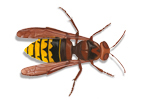Wasps
The term wasp is typically defined as any insect of the order Hymenoptera and suborder Apocrita that is neither a bee nor ant. Almost every pest insect species has at least one wasp species that preys upon it or parasitizes it, making wasps critically important in natural control of their numbers, or natural biocontrol. Parasitic wasps are increasingly used in agricultural pest control as they prey mostly on pest insects and have little impact on crops. The majority of wasp species (well over 100,000 species) are "parasitic" (technically known as parasitoids), and the ovipositor is used simply to lay eggs, often directly into the body of the host. .
Generally wasps are parasites or parasitoids as larvae, and feed only on nectar as adults. Many wasps are predatory, using other insects (often paralyzed) as food for their larvae. A few social wasps are omnivorous, feeding on a variety of fallen fruit, nectar, and carrion. Some of these social wasps, such as yellowjackets, may scavenge for dead insects to provide for their young. In many social species the larvae provide sweet secretions that are fed to the adults.
Social Wasps
Family: Vespidae, e.g. Vespula vulgaris
Appearance

• Yellow and black abdomen. Markings will differ according to species.
Lifecycle
• Young Queens overwinter and emerge in the spring to start nest building and lay eggs.
• Workers (sterile females) emerge during early summer and take over nest building. Queen continues to lay eggs.
• New queens and males mate in early autumn.
• Nest dies during winter, including all the males and workers. Only Queens survive to the next year.
Habits
• Colony size — medium to large (up to as many as 25,000 individuals).
• Preferred nest sites — lofts, wall cavities, old rodent burrows, hollow trees and bushes.
• Nest construction — pulped wood (paper). Combs set horizontally. A new nest is produced each year.
• Swarming — does not swarm.
• Food preferences — will take insects and sweet foods.
• Stings readily and repeatedly.
Hornets
Vespa crabro
Appearance

• Large, up to 1.8 inches long.
• Wings are reddish-orange.
• Orange abdomen with brown stripes.
Lifecycle
• Nests are founded in the Spring.
• Most die-off by late Autumn.
• Only the fertilized Queen overwinters.
Habits
• Nesting – In sheltered places, e.g. tree trunks, bushes, sides of buildings, barns, attics, hollow walls. Their nests are grey and paper-like.
• A colony can reach a size of 700 workers.
• Sting - Only sting when provoked. Sting is painful to humans. They can bite and sting at the same time. They can mobilize the entire nest to sting in defence which is highly dangerous to humans.
• Feeding - Live insects and sap. Are not attracted to human food.


